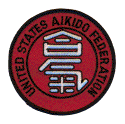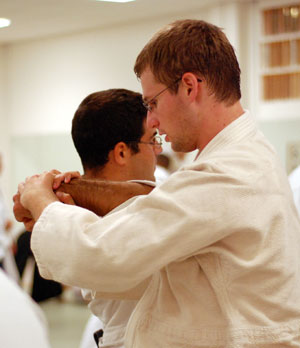|
New Students
Let's welcome our newest
students, George, Jonathan, Saimir, and Kevin. We're thrilled
you've joined our school. Train hard and have fun.
Recent Promotions
Sensei is very happy to
announce the following promotions: David, 3rd kyu; Leslie, 3rd kyu; and
Christine, 5th kyu. All three tested at our grand opening seminar
with Peter Bernath Shihan. Your hard work paid off -
congratulations.
Upcoming Seminars
Paul Cobo Sensei of Aikido
of Tampa Bay will host Grady Lane Shidoin of Brevard Aikikai on March
14. Grady Lane will
host Robert Zimmerman Shihan of Toronto Aikikai
on June 27 and 28. We'll keep you posted.
Camping Trip
It's that time of year
again: The birds are chirping, the temperature is dropping.
It can only mean one thing...our annual camping trip. Let's hope
this year no one catches hypothermia. If you recall, last year we
camped at Huguenot Memorial Park. (You can read all about it in
our April 2008 newsletter.) What could be better? A blazing
campfire, scary ghost stories, and Aikido. Interested? You
know the drill.
Dojo News
Instructors, please
remember to witness the waivers for new students. It only takes a
moment, and is important for school administration. Domo!
Sensei has also asked that
everybody please dispose of their trash after class. We want to
keep the school clean, which is difficult with plastic cups scattered
hither and yon.
For those who may not know,
Sensei keeps a stash of bottled water and soft drinks in the dojo
refrigerator, behind her desk. All we ask is a small donation,
which keeps the goodie bar stocked. Enjoy!
Lastly, we've finalized the
test requirements
for our children's class, which you can also find on
our class information and multimedia pages. We spent a fair amount of time
organizing the children's kyu ranks, and believe it reflects the
priorities Sensei wishes to emphasize to her students.
Fortunately, we had some help. In particular, we owe a tremendous debt
of gratitude to Sue and Steve from Palm Beach Aikikai, who kindly
provided their test requirements, which we liberally drew upon.

|
|
|
Grand Opening Seminar with Peter Bernath Shihan
On Saturday, January 17,
we celebrated the grand opening of the Dupont Dojo with Peter Bernath Shihan of Florida Aikikai.
The seminar was a great success, with students attending from across
Florida. Sensei would especially like to thank the following
visiting instructors, whose participation ensured a wonderful
experience: Grady Lane Sensei from Brevard Aikikai, Jason Baran Sensei
from the UCF Butokukan Club, Sue and Steve from Palm Beach Aikikai, Ted
from the Aiki O-Kami Society, and Jim Saba Sensei from Mushin Dojo.
Of course, our warmest
gratitude is reserved for Bernath Sensei. Our students enjoyed the
seminar immensely.
New Years Cleansing Class
Keeping with tradition, our
January 10 misogi was brutal, but exhilarating. Rather than
talk about cleansing class, (you know, the first rule of
Fight Club), we thought we'd show you a few pictures, just to bring back
those suppressed memories.
(Of course, Fight Club rules don't apply once cleansing class is over.
Sensei would like to thank everyone who contributed a dish to the
potluck dinner. The flan was especially delicious, as were the
meatballs, rice and beans, cheese plate....Heck, it was all good.
Here's to starting the New Year in style.)
Mechanics of the Forward Roll by Ryan Szesny
Editors Note: From time to time we
feature student articles in our newsletter. Ryan Szesny, one of our
dedicated students, began his training in April 2008. In this article
Ryan explains the physical principles behind forward ukemi.
 As
an engineering exercise, I
was recently asked to give my analysis of a
forward roll. Before I begin, however, full disclosure: I am an
electrical engineering (EE) student, and make no claim to have any kind
of expertise in human anatomy, mechanical systems, or thermodynamics.
However,
as part of my education as an EE I have a basic
understanding of these subjects. This particular problem is fairly
straightforward, though. As
an engineering exercise, I
was recently asked to give my analysis of a
forward roll. Before I begin, however, full disclosure: I am an
electrical engineering (EE) student, and make no claim to have any kind
of expertise in human anatomy, mechanical systems, or thermodynamics.
However,
as part of my education as an EE I have a basic
understanding of these subjects. This particular problem is fairly
straightforward, though.
At the outset, please note
that the
projectile (in this case, your body) is made to be rigid. Since
your body shape does not change, (at least during the roll itself,
unless something has gone terribly amiss), and further, since no mass is lost,
you possess, according to mechanical theory, a rigid body. In fact, the rigidity of your
body is augmented by your muscles and joint cartilage, which take the
brunt of stress during a fall, thereby relieving at least some
structural strain. In mechanical terms, your joints and muscles
act as a spring, which are compressed by the impact of falling.
Knowing this, the first
step is to define the issue. In our case, the issue is the
interplay between a rigid body and an exchange of energy, or more
plainly stated, a forward throw.
Sensei teaches that rolls are meant to
be taken close to the ground, to minimize injury. The principle
behind her instruction is sound: the less distance an object travels
from its original position, the less potential energy the object
contains. The less energy the object contains, the less severe the
jolt your body will receive at the moment of impact. (This is a
good thing). Since energy can neither be created nor destroyed,
the energy escapes from your body into the ground, partly in the form of
heat, but also as stress on your legs, since you lowered yourself to
take the fall.
The question, however,
naturally arises: Why roll at all?
Why not, in fact, fall straight down, if all we're talking about is transferring
energy from one system to another? Consider figure 1:

Here, the rigid circular
body drops straight down. When force is applied in only one
direction, or vector, there is only one point of impact, at the bottom
of the circle. Assume the circle represents uke. Assume
further that the point of impact represents, say, uke's shoulder.
In the situation described, therefore, the entirety of force
represented by the arrow acts upon uke's shoulder, causing maximum shear
stress at that point. This is not a good thing, and may in fact
cause injury.
We roll to transfer energy forward,
so that the energy we receive is not just transferred downward,
into the mat. Consider figure 2:

Here, we add a force, in
the forward direction. This forward force creates a moment arm,
which causes the body to rotate. This rotation causes you to roll,
which again is a good thing, since the energy now has a path that
doesn't lead straight down. (Ouch!) Essentially, the
energy is defused into the forward roll.
This is why we
roll. We use our rotation to transfer energy from an unwanted
result, as described in figure 1, to one which allows us to practice
another day. Both scenarios expend the same amount of energy.
The difference is that in the latter, the structural integrity of uke is
not tested, potentially to a breaking point.
We have one more wrinkle to
discuss: Returning to our feet. Remember, a rigid body requires
the same amount of energy to fall as it does to return to its former
position. (That pesky law of conservation again.) The entire
process, therefore, is balanced. Ideally, we as Aikidoka should
use that energy, rather than oppose it, to maintain our own balance, on
and off the mat.
Before I wrap up, I want to
address a misconception I sometimes hear about forward rolls. It
is a fallacy to state that the forward and downward motions described in
figure 2 negate each other. In reality, the energy transferred
into the roll is still very much
present. If the vertical force was in fact negated by the
horizontal force, then even a perfect sphere, (or the world's roundest Aikidoka), would not roll. Rather, the startled fellow would
merely slide, on his shoulder in our example. And yes, this would be a bad thing, since the
unlucky Aikidoka could not make use of that rolling motion to transfer
his energy into a graceful upright stance, ready to train again.
Comments?
Questions? I am sure Ryan would appreciate the feedback.
|
|